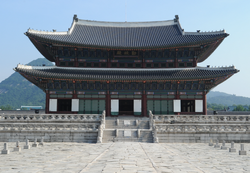Prior to 14th century
| History of Korea |
|---|
 |
| Timeline |
- 18 BCE – Baekje, Wirye-seong, settled. Seoul started functioning as the royal capital of Baekje until 475.
- 475 – Seoul changed hands from Baekje to Goguryeo.
- 551 – Seoul changed hands from Goguryeo to Baekje.
- 553 – Seoul changed hands from Baekje to Silla.
- 901 – Seoul under control of Taebong as Silla became divided into three kingdoms.
- 918 – Seoul became a part of newly founded Goryeo as the prior regime Taebong was overthrown.
- 1104 – Sukjong of Goryeo builds a palace in Seoul and declared it the second capital 'Namgyeong' meaning 'Southern Capital'.
